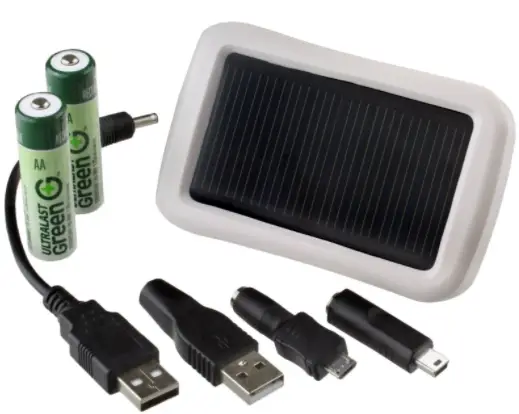
There are tons of battery chargers out there, do you know which ones are solar capable? In this guide, let's check out the 6 best AA solar battery chargers including ones that can charge AAA, C, D and other battery types.
Solar battery chargers provide an environmentally friendly, budget-conscious way to reboot an already semi-renewable resource. It sounds techy, but it’s really a simple application that can come in handy for most consumers.
Best Solar AA Battery Chargers
Sunway Solar AA & AAA Rechargeable Batteries Charger
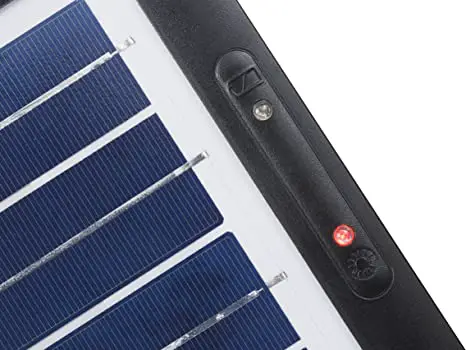
- 7-Bay Battery Charger: This charger can charge up to 7 batteries at once. It has six slots for 1.2V batteries including AA/AAA, and a 9V battery slot.
- 2-Watt Solar Array Lid: The charger has a solar array built right into the lid with the capability of producing up to 2 watts of solar energy. This high wattage allows for fast charging. The panel can even be adjusted to an ideal angle for sunlight absorption by using the handle as a support to tilt the charger.
- LED Indicators: Sunway has built in LED indicators to alert the user when the battery is fully charged. It also alerts the user if the panel is placed under direct sunlight without a battery in the charger.
- Durable Construction: Everything about the build of this solar charger leads to increased durability. There are built-in diodes to prevent reverse charging in order to protect the electrical mechanisms of the device. It is also designed with rugged material included strong ABS plastic housing. Users remark that this product is thick, sturdy, and one of the more durable solar chargers on the market.
C.Crane 11-in-1 Solar Battery Charger
- 11-Bay Battery Charger: The C.Crane charger is capable of charging 11 different NiCd and NiMH battery sizes including AAA, AA, C, D, and 7 GUM sizes. It can charge up to six batteries at once, but only two of each kind at a time. It is also important to note that charging slows with each additional battery in bay. Users have noted that while this charger is capable of charging in array of battery sizes, it works most efficiently when charging AA and AAA batteries.
- Adjustable Solar Array Lid: The battery charger has a 150 mAh solar array built into the lid. The lid is adjustable, and the charger comes equipped with a kickstand to allow for optimal sun exposure. The low amperage of this device means slow charging; however the diverse charging capabilities and many battery bays make this a great choice for charging backup battery sets, especially during an emergency situation.
- Built-in Meter: A built-in meter tells the user the current strength of the sun, the current out-put from the solar panel, and the time required to charge different types of batteries.
- Weather Resistant: A polycarbonate transparent cover makes this device durable and weather resistant.
GoldMaster Solar Powered Battery Charger
- 4-Bay Battery Charger: The GoldMaster solar battery charger can charge four batteries at a time- AA, AAA, C, or D.
- Adjustable Solar Array Lid: This product comes with solar cells built into the lid. The lid can be tilted for optimal light absorption. The manufacturer does not provide the wattage of the panel. While official product reviews state that it can charge four batteries of the same types in about five hours, consumer reviews state that this device is more akin to a trickle charger than a standard battery charger and report longer charge times.
- USB and Various Charging Plugs: This solar panel can do more than power up your AA batteries, it can also directly charge your devices. The built-in USB charging port is compatible with most cell phones and cameras. The device also has various other charging plugs for charging a variety of electronics and devices.
- Indoor/Outdoor Use: This panel is built with weather resistant housing to allow for safe outdoor use. But unlike many other solar battery chargers, it can also be used indoors. Bright sunlight is not necessary for this panel to work, and it can still produce adequate energy when placed indoors at a south-facing window.
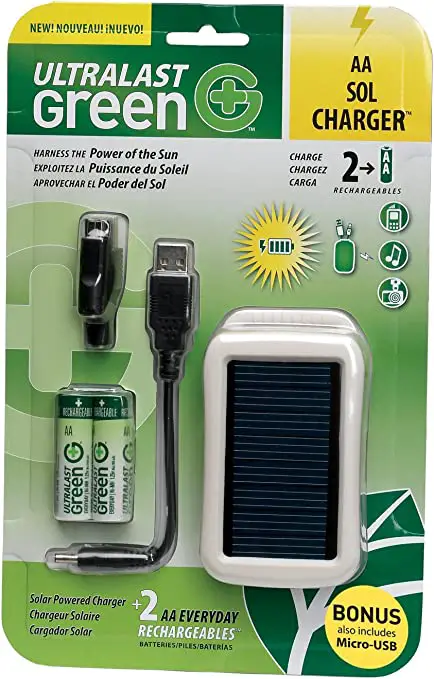
- Built in Solar Array: This solar charger comes equipped with a built in 2100 mAh solar array to allow for fast battery charging of two included batteries.
- Portability: The rugged, compact cover and ultra-light weight make this solar battery charger great for portability. The device weighs only 1 pound, about half that of the competing chargers on this list. It comes with a clip to attach to backpacks, tents, or clothing and a kickstand to help with angling the panel for optimal light absorption.
- Multi-Use USB Port: Option to charge batteries via USB port when sunlight is not accessible. The port can also be used to charge external electronic devices off the fully charged batteries.
- LED Indicator: LED lights tell you charging direction (battery receiving power from solar or USB/ electronic device receiving power from solar/USB).
- BONUS! Eco-Friendly Packaging: Packaging includes post-consumer recycled cardboard and recyclable PET plastic.
Best Solar Compatible AA Battery Chargers
These USB battery chargers do not have solar panels built in, but are capable of being powered by a solar panel. This gives not only gives you multiple charging options, but also gives you the ability to pull from a higher wattage solar panel.
EBL iQuick Smart Battery Charger
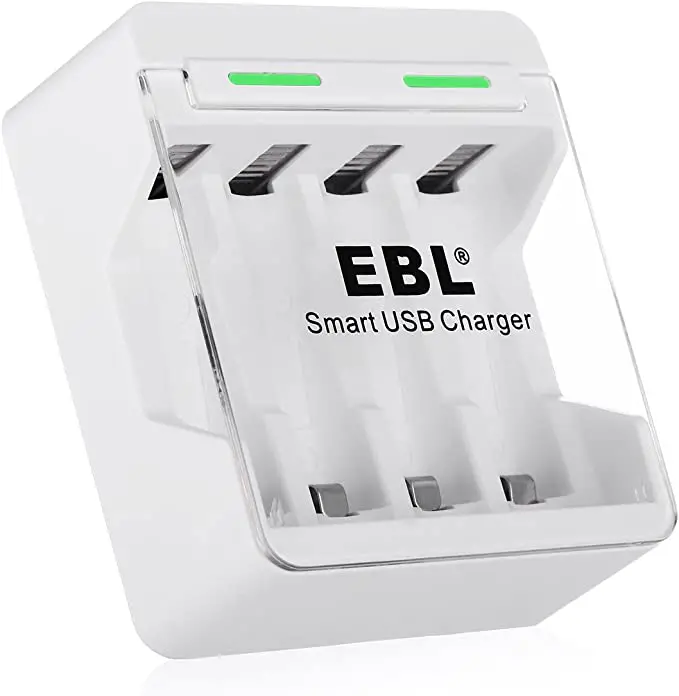
- 4-Bay Battery Charger: the iQuick Charger has 4 individual bays for charging 1/2/3/4 AA/AAA Ni-MH batteries.
- Smart Charger Safety Assurance: An advanced MCU control system enables automatic cut-off charging to prevent over charging batteries, automatic trickle charging mode, and over-current and over-heat protection.
- Includes High-Performance Batteries: This charger comes with 4- AA 2300mAh batteries. These are low self-discharge batteries which reserve 85% power when left sitting for up to one year. These batteries can be fully recharged in the smart charger in 40 minutes.
- Solar-Compatible: While this product does not have a solar array built in, it is solar capable. There USB port where the wall charger plugs in can be used to attach a solar panel of your choosing.
Goal Zero Guide 10 Plus Recharger
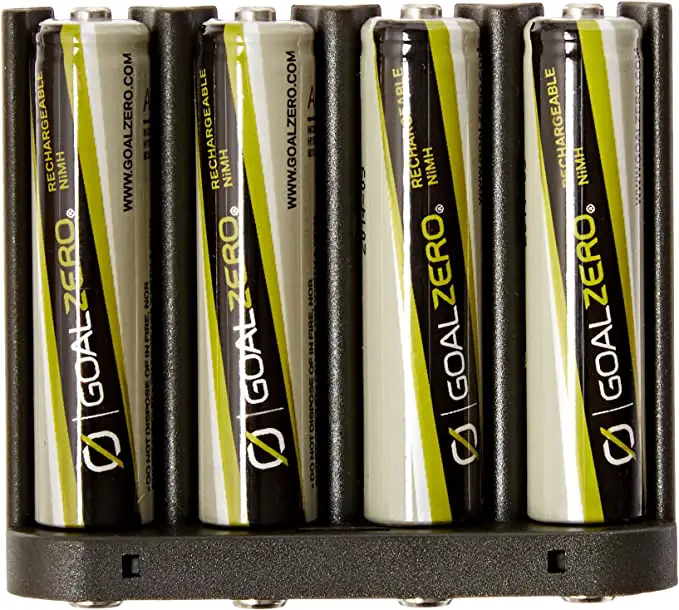
- 4-Bay Battery Charger: The Goal Zero Guide 10 has the ability to charge 4-AA or 4-AAA batteries at once.
- Multi-Use USB Port: A USB port allows for external wall charging. It also allows the user to connect external devices for charging. According to Goal Zero, with four fully charged batteries inserted, the device can recharge your smart phone 1-3 times.
- Compact and Light-Weight: This device weighs only 6.3 ounces and is sized at 3.94 X 2.52 X .75 in. This makes it the smallest device reviewed today. It is important to remember, however, that this does not include the solar array.
- Solar Kit Available: Goal Zero also sells this charger in a solar kit which includes the solar charger, the 2300 mAh Nomad 7 Solar panel, 4-AA batteries, a AAA battery insert, and a removable pouch and kickstand.
Buyer’s Guide
What can you use rechargeable batteries for, and why should you use a solar charger to reboot them? We take an in depth look at these common questions below.
How Does It Work?
Using photovoltaic rays from the sun, the PV glass converts light into energy. This is then transferred into your AA, AAA, C, D, and other batteries to be used in your favorite devices. Simply put the batteries in the charging bay and place the device somewhere sunny. Within mere hours, your batteries will be good as new again.
Types Of Rechargeable Batteries
There are two main categories of batteries used today:
- Primary cell batteries - Alkaline disposable batteries
- Secondary cell batteries - Rechargeable batteries
Rechargeable batteries include:
- NIMH (AAA & AA) - Better choice for general purpose use
- NICD (AAA & AA) - Good for high temperature applications
- LiPo
- NiFe
(See complete list of battery types)
They come in a variety of sizes including AA, AAA, C, D. These batteries have the capability to restore their energy capacity with the aid of an electrical current provided by a charger.
Rechargeable batteries are used in every day applications spanning from your cell phone to your automobile. They can last up to 200 charging cycles, making them both convenient for the user and responsible for the environment.
Why Use a Solar Charger?
The main reason people are drawn to solar chargers is location freedom. The ability to use the sun as a power source means you don’t have to be tied to the power grid. This is great for remote homes and worksites as well as nature enthusiasts including those that enjoy hiking, camping, and boating.
There are other less obvious scenarios where on the go charging may come handy too. For example, students can benefit from solar charging by attaching a solar panel to their backpack. While walking to class or lounging in the quad between classes, battery powered devices can be rebooting.
Another reason to choose a solar device to power up your rechargeable batteries is the application’s decreased impact on our current environmental crises. Solar cells generate no emissions, waste, or byproducts during use. Many people may not realize the implications that come with using modern day electricity.
The act of plugging a charger into the wall seems like such a small and harmless act. However, in a study done in 2018 it was found that 6.4 megatons of greenhouse gases were emitted in a single year from cell phone charging alone, and that number is growing immensely year by year.
By 2040, it is predicted that 14% of our global footprint will come from societal communications and information technology such as our laptops, smart phones, and tablets.
Who Can Benefit from Using a Solar Charger for AA, AAA, D Cell, NIMH, NICD Batteries?
Anyone that uses a device charged by a secondary cell battery can benefit from investing in solar battery charger.
Devices that use the batteries listed above include flashlights and other light sources, portable radios, walkies, toys, shavers, torches, remote controls, cameras, wireless keyboards, and other digital devices.
I personally use rechargeable batteries for a portable keyboard so that I can play music in the park and while camping!
If you are interested in using rechargeable batteries for light sources, check out our article on the best AA Batteries for Solar Light for more information.
Is Using a Solar Battery Charger for AA Batteries Really Necessary?
It isn’t necessary to use a solar battery charger for AA batteries. Plugging into a wall charger is an easy alternative.
However this does come with the standard drawbacks of tying into the power grid. These drawbacks include high costs, location restrictions, susceptibility to outages, and negative environmental impacts.
Safety
As with any new venture, it is best to be well informed before getting started. While recharging batteries is a simple hands-off process, there are still a few safety precautions you should keep in mind.
What to Be Aware of When Charging These Batteries
Rechargeable batteries can be easily damaged if they are not charged properly. Always make sure to use a cord and charger compatible with the battery. Additionally, make sure the battery is compatible with device you wish to power.
To avoid overheating and prevent fire hazards during charging, place the battery charger on a non-flammable surface with good air circulation around the device.
It is also imperative to be sure that a battery is in fact rechargeable before trying to recharge it. Charging a disposable battery can lead to a break in the battery seal causing the battery to leak severely hazardous chemicals or even explode or burst into flames.
Lastly, safety measures should continue even after the battery has reached the end of its final lifecycle. Batteries are not biodegradable and can be quite toxic.
It is important to properly recycle your used batteries so that they do not end up in a landfill. Most towns have centers that will accept used batteries for recycling.
How to Tell If a Battery Is Made to Be Recharged?
One way to tell if a battery is rechargeable is to check the voltage. A standard disposable battery has a voltage of 1.5.
In comparison, a typical rechargeable battery has a voltage of 1.2. However, this test is not fool proof. A standard battery loses efficiency over time. At first use it will carry a voltage of 1.5V, reducing to about 1.0V by the end of its lifetime.
A reading of 1.2V in the middle stages of a disposable battery’s life cycle is possible, therefore this test should be administered at first use to ensure accuracy.
Wrap up
As shown above, different solar chargers work better for different needs. Features include number and type of battery bays, wattage of built-in solar arrays, durability, and more.
All of the solar battery chargers detailed above will work great for emergency kits, hiking equipment, or a fun-filled day at the park.
Have you tried one of these devices? Be sure to reach out and share your experience with us!
Related Content:
